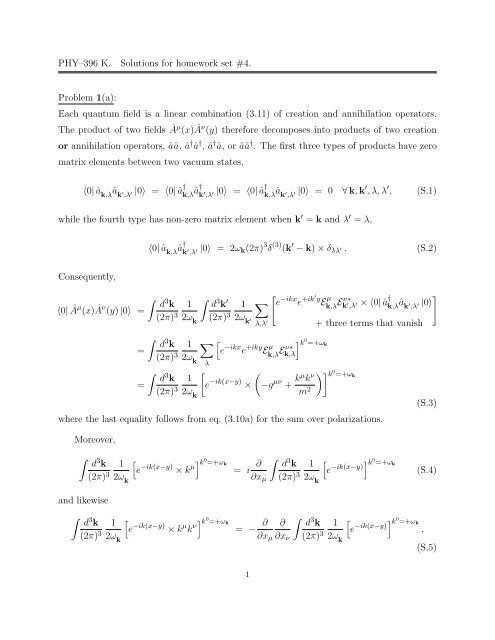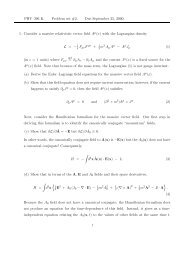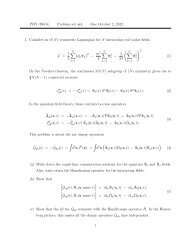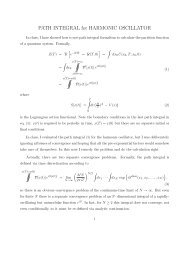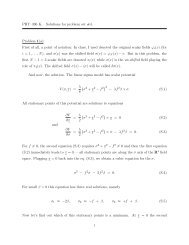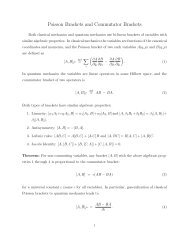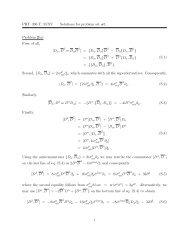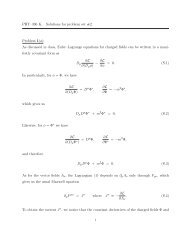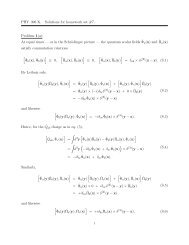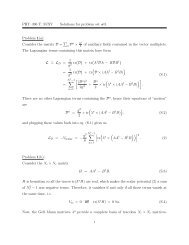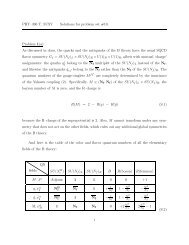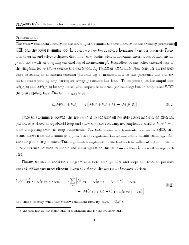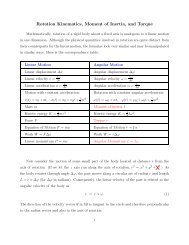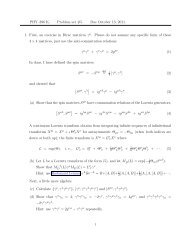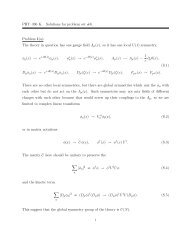PHYâ396 K. Solutions for homework set #4. Problem 1(a): Each ...
PHYâ396 K. Solutions for homework set #4. Problem 1(a): Each ...
PHYâ396 K. Solutions for homework set #4. Problem 1(a): Each ...
- No tags were found...
Create successful ePaper yourself
Turn your PDF publications into a flip-book with our unique Google optimized e-Paper software.
PHY–396 K. <strong>Solutions</strong> <strong>for</strong> <strong>homework</strong> <strong>set</strong> <strong>#4.</strong><strong>Problem</strong> 1(a):<strong>Each</strong> quantum field is a linear combination (3.11) of creation and annihilation operators.The product of two fields µ (x)Âν (y) there<strong>for</strong>e decomposes into products of two creationor annihilation operators, ââ, â † â † , â † â, or ââ † . The first three types of products have zeromatrix elements between two vacuum states,〈0| â k,λ â k′ ,λ ′ |0〉 = 〈0| â † k,λ↠k ′ ,λ ′ |0〉 = 〈0| â † k,λâk ′ ,λ ′ |0〉 = 0 ∀ k, k ′ , λ, λ ′ , (S.1)while the fourth type has non-zero matrix element when k ′ = k and λ ′ = λ,〈0| â k,λ â † k ′ ,λ ′ |0〉 = 2ω k (2π) 3 δ (3) (k ′ − k) × δ λλ′ . (S.2)Consequently,〈0| µ (x)Âν (y) |0〉 ===∫ d 3 ∫ [k 1 d 3 k ′ 1 ∑ e −ikx e +ik′y E µ k,λ Eν∗ k ′ ,λ × 〈0| ]′ ↠k,λâk ′ ,λ|0〉 ′(2π) 3 2ω k(2π) 3 2ω k′λ,λ ′ + three terms that vanish∫ d 3 k 1 ∑ [] k(2π) 3 e −ikx e +iky E µ 0 =+ω k2ωk,λ Eν∗ k,λk∫ d 3 k(2π) 3 12ω k[e −ik(x−y) ×λ(−g µν + kµ k νm 2 )] k 0 =+ω kwhere the last equality follows from eq. (3.10a) <strong>for</strong> the sum over polarizations.Moreover,(S.3)∫ d 3 k(2π) 3 12ω k[e −ik(x−y) × k µ] k 0 =+ω kand likewise= i∂∂x µ∫ d 3 k(2π) 3 12ω k[e −ik(x−y)] k 0 =+ω k(S.4)∫ d 3 k(2π) 3 12ω k[e −ik(x−y) × k µ k ν] k 0 =+ω k∫∂ ∂ d 3 k 1[= −∂x µ ∂x ν (2π) 3 e −ik(x−y)] k 0 =+ω k,2ω k(S.5)1
which allows us to rewrite the last line of eq. (S.3) as〈0| µ (x)Âν (y) |0〉 ==(−g µν − 1 ∂ 2 ) ∫ d 3 k 1[m 2 ∂x µ ∂x ν (2π) 3 2ω k(−g µν − 1 ∂ 2 )m 2 D(x − y).∂x µ ∂x νe −ik(x−y)] k 0 =+ω k(S.6)Q.E.D.<strong>Problem</strong> 1(b):In light of eq. (3.18) <strong>for</strong> the vacuum sandwich, we immediately see that <strong>for</strong> the un-modifiedtime-ordering,〈0| Tµ (x)Âν (y) |0〉 = Θ(x 0 − y 0 ) 〈0| µ (x)Âν (y) |0〉 + Θ(y 0 − x 0 ) 〈0| Âν (y)µ (x) |0〉(= Θ(x 0 − y 0 ) −g µν − 1 ∂m 2+ Θ(y 0 − x 0 )On the other hand, we saw in class that∂x µ(−g µν − 1 ∂m 2 ∂x µ)∂D(x − y)∂x ν)∂D(y − x).∂x ν(S.7)G scalarF (x − y) = Θ(x 0 − y 0 )D(x − y) + Θ(y 0 − x 0 )D(y − x) (S.8)and also∂G scalarF (x − y) = Θ(x 0 − y 0 ∂D(x − y)) + Θ(y 0 − x 0 ∂D(y − x))∂x 0 ∂x 0 ∂x 0(S.9)but∂ 2∂x 2 0G scalarF (x−y) = Θ(x 0 −y 0 ) ∂2 D(x − y)∂x 2 0+ Θ(y 0 −x 0 ) ∂2 D(y − x)∂x 2 0− iδ (4) (x−y). (S.10)Since the space derivatives commute with the Θ functions of times, eqs. (S.8) through (S.10)2
imply∂ x∂ µ xG ν scalarF (x−y) = Θ(x 0 −y 0 ) ∂ x∂ µ xD(x−y) ν + Θ(y 0 −x 0 ) ∂ x∂ µ xD(y−x) ν − iδ µ0 δ ν0 δ (4) (x−y)and there<strong>for</strong>e(S.11)(−g µν − ∂µ x∂xν )(m 2 G scalarF (x − y) = Θ(x 0 − y 0 ) −g µν − ∂µ x∂xν )m 2 D(x − y)(+ Θ(y 0 − x 0 ) −g µν − ∂µ x∂xν )m 2 D(y − x)〈〈 in light of eq. (S.7) 〉〉+ iδµ0 δ ν0m 2 δ (4) (x − y)= 〈0| Tµ (x)Âν (y) |0〉 + iδµ0 δ ν0≡ 〈0| T ∗  µ (x)Âν (y) |0〉m 2 δ (4) (x − y)(S.12)where the last equality is the definition (3.20) of the modified time-ordered product of vectorfields.The above proves the first line of eq. (3.19); the second line follows from the momentumspace<strong>for</strong>m of the scalar propagator:∫ dG scalar4 kF (x − y) =(2π) 4ie −ik(x−y)k 2 − m 2 + i0 ,(S.13)hence(G µνF (x − y) = −g µν − ∂µ x∂xν )∫ dm 2 G scalar4 (kF (x − y) =(2π) 4 −g µν + kµ k ν )m 2Q.E.D.ie−ik(x−y)k 2 − m 2 + i0 .(S.14)3
<strong>Problem</strong> 1(c):The classical Lagrangian of the free massive vector field isL = − 1 4 F νµF νµ +2 1m2 A µ A µ= − 1 2 (∂ νA µ )(∂ ν A µ − ∂ µ A ν ) + 1 2 m2 A µ A µ(S.15)= 1 2 A (µ ∂ 2 A µ + m 2 A µ − ∂ µ ∂ ν )A ν + a total derivative.Integrating this Lagrangian gives us the classical action as∫∫S = d 4 x L = 1 2d 4 x A µ (x) D µν A ν (x)(S.16)where D µν is the second-order differential operatorThis verifies eq. (3.21).D µν = (∂ 2 + m 2 ) × g µν − ∂ µ ∂ ν . (S.17)Now let’s apply the operator (S.17) to the Feynman propagator (3.19) of the vectorfields. Using the top line of eq. (3.19) relating G F νλto scalar propagator, we obtain(D µν G F νλ (x − y) = (∂ 2 + m 2 ) g µν − ∂ µ ∂ ν) ( −g νλ − 1 )m 2 ∂ ν∂ λ G scalarF (x − y)=⎛− δ µ λ × (∂2 + m 2 ) + ∂ µ ⎞∂ λ− ∂2 + m 2⎜ m⎝2 × ∂ µ ∂ λ + ∂ µ × ∂2m 2 × ∂ λ⎟⎠ × Gscalar F (x − y)= −δ µ λ × (∂2 + m 2 ) + 0 × ∂ µ ∂ λ(S.18)= −δ µ λ × (∂2 + m 2 )G scalarF (x − y).But the scalar propagator is the Green’s function of the Klein–Gordon operator (∂ 2 + m 2 ),which immediately gives us(∂ 2 + m 2 )G scalarF (x − y) = −iδ (4) (x − y), (S.19)D µν G F νλ (x − y) = +iδµ λ δ(4) (x − y).(S.20)In other words, the vector propagator is the Green’s function of the differential operatorD µν ,Q.E.D.4
<strong>Problem</strong> 3(a):[Ĵi , Ĵj] ≡ 1 4 ɛikl ɛ jmn [ Ĵ kl , Ĵmn] = 〈〈 by eq. (1) 〉〉(= 1 4 ɛikl ɛ jmn −ig km Ĵ ln + ig kn Ĵ lm + ig lm Ĵ kn − g ln Ĵ km)〈〈 by antisymmetry of ɛ’s 〉〉= ɛ ikl ɛ jmn × −ig km Ĵ ln= iĴln ×(−g km ɛ ikl ɛ jmn = +δ km ɛ ikl ɛ jmn = δ ij δ ln − δ in δ lj)= 0 − iĴji = +iĴij≡ +iɛ ijk Ĵ k .(S.21)[Ĵi , ˆK j] ≡ 1 2 ɛikl [ Ĵ kl , Ĵ0j] = 〈〈 by eq. (1) 〉〉= 1 2 ɛikl ( −ig k0 Ĵ lj + ig kj Ĵ l0 + ig l0 Ĵ kj − ig lj Ĵ k0)= 1 2 ɛikl ( 0 − iδ kj Ĵ l0 + 0 + iδ lj Ĵ k0)≡ 1 2 ɛikl ( +iδ kj ˆKl − iδ lj ˆKk )= 1 2 ɛijl ˆKl − 1 2 ɛikj ˆKj[ ˆKi , ˆK j] ≡[Ĵ0i , Ĵ0j] = 〈〈 by eq. (1) 〉〉= ɛ ijk ˆKk , (S.22)= −ig 00 Ĵ ij + ig 0j Ĵ i0 + ig i0 Ĵ 0j − ig ij Ĵ 00= −iĴij + 0 + 0 + 0,≡ −iɛ ijk Ĵ k .(S.23)<strong>Problem</strong> 3(b):[ˆV i , Ĵj] ≡ 1 2 ɛjkl [ ˆV i , Ĵkl] = 1 2 ɛjkl ( ig ik ˆV l − ig il ˆVk )= 1 2 ɛjkl ( −iδ ik ˆV l + δ il ˆVk ) = − i 2 ɛjil ˆV l + i 2 ɛjki ˆVk= iɛ ijk ˆV k , (S.24)5
[ˆV 0 , Ĵj] = 1 2 ɛjkl [ ˆV 0 , Ĵkl] = 1 2 ɛjkl ( i\g 0k ˆV l − i\g 0l ˆVk )= 0, (S.25)[ˆV i , ˆK j] =[ˆV i , Ĵ0j] = i\g i0 ˆVj− ig ij ˆV0= +iδ ij ˆV 0 , (S.26)[ˆV 0 , ˆK j] =[ˆV 0 , Ĵ0j] = ig 00 ˆVj− i\g 0j ˆV0= +i ˆV j . (S.27)Note that the Hamiltonian of a relativistic theory is a member of a 4-vector multiplet ˆP µ =(Ĥ, ˆP) where ˆP is the net momentum operator. Applying the above equations to the ˆP µvectors, we obtain[ˆP i , Ĵj] = iɛ ijk ˆP k ,[Ĥ, Ĵ j] = 0,[ˆP i , ˆK j] = +iδ ij Ĥ,(S.28)[Ĥ, ˆKj ] = +i ˆP j .In particular, the Hamiltonian Ĥ commutes with the three angular momenta Ĵj but it doesnot commute with the three generators ˆK k of the Lorentz boosts.Comment: In the ordinary quantum mechanics, it is often said that generators of continuoussymmetries must commute with the Hamiltonian operator. However, this is true only <strong>for</strong> thesymmetries that act in a time independent manner — <strong>for</strong> example, rotating the 3D spaceby the same angle at all times t. But when the trans<strong>for</strong>mation rules of a symmetry dependon time, the Hamiltonian must change to account <strong>for</strong> this time dependence.In a Lorentz boost, the trans<strong>for</strong>m x → x ′ obviously depends on time, which changesthe way the trans<strong>for</strong>med quantum fields such as ˆΦ ′ (x, t) depend on t. Consequently, theHamiltonian Ĥ of the theory must change so that the new Heisenberg equations wouldmatch the new time dependence. In terms of the generators, this means that the boostgenerators ˆK i should not commute with the Hamiltonian.6
Note that this non-commutativity is not caused by Lorentz boosts affecting the timeitself, t ′ = L 0 µx µ ≠ t. Even in non-relativistic theories — where the time is absolute —generators of symmetries that affect the other variables in a time-dependent matter do notcommute with Ĥ.For example, consider a Galilean trans<strong>for</strong>m from one non-relativistic moving frame intoanother, x ′ = x + vt but t ′ = t. This is a good symmetry of non-relativistic particlesinteracting with each other but not subject to any external potential,Ĥ = ∑ a12M ˆp2 a + 1 2∑V (ˆx a − ˆx b ).a≠b(S.29)A unitary operatoroperators asĜ realizing a Galilean symmetry acts on coordinate and momentumĜˆx a Ĝ † = ˆx a + vt, Ĝˆp a Ĝ † = ˆp a + Mv, (S.30)and it also trans<strong>for</strong>ms the Hamiltonian intoĜĤĜ† = Ĥ + v · ˆP tot + 1 2 M totv 2 . (S.31)In terms of the Galilean boost generators ˆK G ,Ĝ = exp ( −iv · ˆK G),[ˆx i a, ˆK j G]= iδ ij × t,[ˆp i a, ˆK]jGIn particular, the ˆK G i do not commute with the Hamiltonian.= iMδ ij ,] [Ĥ, ˆKjG= i ˆP i tot .(S.32)<strong>Problem</strong> 3(c):Consider a linear combination 1 2 N µνĴµν of Lorentz generators with some generic coefficientsN µν = −N νµ . The Lorentz symmetries L(N, φ) = exp( iφ 2 N µνĴµν ) generated by this combinationpreserve the momentum p µ of the particle state |p〉 if and only ifexp ( iφ2 N µνĴµν) ˆP α exp ( − iφ 2 N µνĴµν) |p〉 = ˆP µ |p〉 . (S.33)7
For an infinitesimal φ, this condition becomes[iφ2 N µνĴµν , ˆP α] |p〉 = 0. (S.34)Applying eqs. (3) to the left hand side of this <strong>for</strong>mula gives us[iφ2 N µνĴµν , ˆP α] |p〉 = iφ 2 N µν(−ig αµ ˆP ν + g αν ˆPµ ) |p〉= φN αν ˆPν |p〉(S.35)= φN αν p ν |p〉 ,so the condition <strong>for</strong> the generator 1 2 N µνĴµν to preserve particle’s momentum p µ is simplyN αν × p ν = 0. (S.36)In 3D terms, N ij = ɛ ijk a k and N 0k = −N k0 = b k <strong>for</strong> some 3-vectors a and b, thegenerator in question is12N µν Ĵ µν = a · Ĵ + b · ˆK, (S.37)and the condition (S.36) becomesa × p − bE = 0 and b · p = 0. (S.38)Actually, the second condition here is redundant, so the general solution isany a, b = a × p E . (S.39)In terms of eq. (S.37), these solutions mean12N µν Ĵ µν = a · Ĵ + (a × p) · ˆKE= a ·p)(Ĵ +E × ˆK<strong>for</strong> any a.(S.40)In other words, the Lorentz symmetries preserving the momentum p µ have 3 generators,8
namely the components of the 3-vectorĴ + p E × ˆK(S.41)For a particle moving in z direction at speed β = p z /E, these components areĴ x − β ˆK y , Ĵ y + β ˆK x , and Ĵ z . (S.42)Naturally, the generators of any symmetry are defined up to linear combinations. Thus,any 3 linearly-independent combination of the operators (S.42) will generate the same littlegroup G(p) of Lorentz symmetries preserving the momentum p µ . In particular, in eq. (4) Ihave multiplied 2 of the generators (S.42) by the Lorentz slowdown factor γ while leavingĴ z as it is. The purpose of this rescaling is to make all 3 generators normalized as angularmomenta, see part (d) below.<strong>Problem</strong> 3(d):[Ĵz , ˜J x] [Ĵz [Ĵz = γ , Ĵx] − βγ ,ˆKy]= γ × iĴy − βγ × (−i ˆK x )= i ˜J y ,[Ĵz , ˜J y] [Ĵz [Ĵz = γ , Ĵy] + βγ ,ˆKx]= γ × (−iĴx ) − βγ × (+i ˆK y )(S.43)= −i ˜J x ,[ ˜Jx , ˜J y] = γ 2 [ Ĵ x , Ĵy] − βγ 2 [ ˆKy , Ĵy] + βγ 2 [ Ĵ x , ˆK x ,]= γ 2 × iĴz − 0 + 0 − β 2 γ 2 × iĴz= iĴz × ( γ 2 (1 − β 2 ) = 1 ) = iĴz .− β 2 γ 2 [ ˆKy ,ˆKx]9
<strong>Problem</strong> 3, comment to eq. (5):For a massless particle, the generators of the little group of its momentum are exactly as ineq. (S.42) <strong>for</strong> β = 1 (a massless particle moves at the speed of light). Indeed, the analysisof part (c) above goes through without any changes, except we cannot rescale two of thegenerators by a factor of γ because a massless particle has γ = ∞.Without the γ factors, the commutation relations [Ĵz , Îx ] = iÎy and [Ĵz , Îy ] = −iÎxwork exactly as in the first two eqs. (S.43), but in the third equation we get[Îx , Îy] = iĴz × (1 − β 2 ) 〈〈 without the γ 2 factor 〉〉 = 0. (S.44)<strong>Problem</strong> 3(e):The quantum state |p, λ〉 has definite momentum p µ , thus ˆP α |p, λ〉 = p α |p, λ〉 and likewiseɛ αβγδ Ĵ βγ ˆP δ |p, λ〉 = ɛ αβγδ p δ Ĵ βγ |p, λ〉 .(S.45)For simplicity, let’s assume the particle moves in the z direction and spell out the operatorˆQ α = ɛ αβγδ p δ Ĵ βγ in components:ˆQ 0 = ɛ 0ij3 p 3 × Ĵij = 2p 3 × Ĵ12 = 2p z × J z ,ˆQ 1 = ɛ 1023 p 3 × Ĵ02 + ɛ 1203 p 3 × Ĵ20 + ɛ 1jk0 p 0 × Ĵjk= −2p 3 × Ĵ02 − 2p 0 × Ĵ23 = −2p z × ˆK y − 2p 0 × Ĵx ,ˆQ 2 = ɛ 2013 p 3 × Ĵ01 + ɛ 2103 p 3 × Ĵ10 + ɛ 2jk0 p 0 × Ĵjk(S.46)= +2p 3 × Ĵ01 − 2p 0 × Ĵ31 = +2p z × ˆK x − 2p 0 × Ĵy ,ˆQ 3 = ɛ 3ij0 p 0 × Ĵij = −2p 0 × Ĵ12 = −2p 0 Ĵ z .For a massless particle with p z = p 0 = E, these components simplify toˆQ 0 = +2E × Ĵz , ˆQx = −2E × Îx , ˆQy = −2E × Îy , ˆQz = −2E × Ĵz . (S.47)Besides definite momentum, the state |p, λ〉 has definite helicity λ,Ĵ z |p, λ〉 = λ |p, λ〉.Moreover, it is annihilated by other two generators of the little group of its momentum,10
Î x |p, λ〉 = Îy |p, λ〉 = 0. There<strong>for</strong>e, when we apply the operators (S.47) to this state, weobtainˆQ 0 |p, λ〉 = +2Eλ |p, λ〉 ,ˆQ x |p, λ〉 = 0,ˆQ y |p, λ〉 = 0,(S.48)ˆQ z |p, λ〉 = −2Eλ |p, λ〉 ,Comparing the right hand sides here to the particle momentum (with a lower index) p α =(+E, 0, 0, −E) we see thatˆQ α |p, λ〉 = 2λp α |p, λ〉 .(S.49)In other words,ɛ αβγδ Ĵ βγ ˆP δ |p, λ〉 = 2λ ˆP α |p, λ〉 . (6)becomeWhat if a massless particle moves in another direction? In 3-vector notations, eqs. (S.46)ˆQ 0 = 2E ⃗ β · Ĵ, ˆQ = 2E ( Ĵ + ⃗ β × ˆK ) . (S.50)Up the overall factor 2E, the components of ˆQ are the generators (S.42) of the little groupof the momentum p µ .A singlet multiplets of this little group is annihilated by the twogenerators ⊥p and is an eigenstate of the third generator ‖p. Indeed, <strong>for</strong> a massless particle⃗β · Ĵ is the helicity operator, henceˆQ 0 |p, λ〉 = 2Eλ |p, λ〉 , ⃗ β · ˆQ |p, λ〉 = 2E ⃗ β · Ĵ |p, λ〉 = 2Eλ |p, λ〉 , (S.51)while⃗β × ˆQ |p, λ〉 = 0.(S.52)Consequently,ˆQ |p, λ〉 = β ⃗ ( )⃗β · ˆQ |p, λ〉 − β ⃗ × β ⃗ × ˆQ |p, λ〉 = β ⃗ (2Eλ |p, λ〉) = 2pλ |p, λ〉 ,(S.53)11
and combining this <strong>for</strong>mula with ˆQ 0 |p, λ〉 = 2Eλ |p, λ〉 we obtainˆQ µ |p, λ〉 = 2λp µ |p, λ〉 .(S.54)This proves eq. (6) <strong>for</strong> a massless particle moving in any direction.Now consider a continuous Lorentz trans<strong>for</strong>m x µ → x ′µ = L µ νx ν . The operators on bothsides of both sides of eq. (6) trans<strong>for</strong>m as Lorentz vectors,ˆD(L) ˆP α ˆD† (L) = L µα ˆP µ , ˆD(L)(ɛ αβγδ Ĵ βγ ˆPδ ) ˆD† (L) = L µα(ɛ µβγδ Ĵ βγ ˆPδ ) .(S.55)Consequently, the trans<strong>for</strong>med stateˆD |p, λ〉 = |Lp, ??〉(S.56)satisfies the same eq. (6) as the original state |p, λ〉. Indeed,(L αµ ɛ µβγδ Ĵ βγ δ ˆP ) |Lp, ??〉 =ˆD(L)(ɛ αβγδ Ĵ βγ δ ˆP ) ˆD† (L) × ˆD |p, λ〉(ɛ αβγδ Ĵ βγ δ ˆP ) |p, λ〉= ˆD(L) ×〈〈 by eq. (6) 〉〉= ˆD(L) × 2λ ˆP α |p, λ〉(S.57)and hence= 2λ × ˆD(L) ˆP α ˆD† (L) × ˆD |p, λ〉= 2λ × L µα ˆP µ |Lp, ??〉 ,(ɛ µβγδ Ĵ βγ ˆPδ ) |Lp, ??〉 = 2λ ˆP µ |Lp, ??〉 .(S.58)Note that this equation <strong>for</strong> the trans<strong>for</strong>med state |Lp, ??〉 has exactly the same helicityeigenvalue λ as the original eq. (6). Physically, this means that the trans<strong>for</strong>med state hasthe same helicity as the original state — <strong>for</strong> massless particles, continuous Lorentz trans<strong>for</strong>mspreserve helicity!12
<strong>Problem</strong> 4(a):In light of eqs. (2),[Ĵi ± , Ĵj ±]= 1 4[Ĵi [, Ĵj] ±4i ˆKi , Ĵj] ±4i [Ĵi , ˆK j] [−41 ˆKi ,ˆKj]= 1 4 iɛijk Ĵ k ± i 4 iɛijk ˆKk ± i 4 iɛijk ˆKk − 1 4 (−i)ɛijk Ĵ k= ɛ ijk ( i2 Ĵ k ∓ 1 2 ˆK k) = iɛ ijk Ĵ k ± ,[Ĵi ± , Ĵj ∓]= 1 4[Ĵi [, Ĵj] ±4i ˆKi , Ĵj] ∓4i [Ĵi , ˆK j] [+41 ˆKi ,ˆKj](S.59)= 1 4 iɛijk Ĵ k ± i 4 iɛijk ˆKk ∓ i 4 iɛijk ˆKk + 1 4 (−i)ɛijk Ĵ k= 0.<strong>Problem</strong> 4(b):First of all, <strong>for</strong> any complex matrix A, ( A n) † =(A† ) n and hence <strong>for</strong> any function f thatexpands into a power series with real coefficients, ( f(A) ) † = f(A† ) . In particular,(exp(A)) † = exp(A† ) =⇒( (exp(A) ) †) −1= exp(−A† ) . (S.60)Now, in eq. (8) <strong>for</strong> M, the 3-vectors a and b are real and the Pauli matrices σ x,y,z arehermitian. So if we letA = 1 2 (−ia + b) · σ,(S.61)then−A † = 1 2 (−ia − b) · σ. (S.62)Plugging these A and A † into eq. (S.60) and comparing to eqs. (8) and (9) we immediatelyobtainM = exp(A), M = exp ( −A †) =⇒(M †) −1= M. (10a)To prove the second equality in eq. (10) we need the Pauli-matrix relationσ 2 σ ∗ σ 2 = −σ, (S.63)which follows from σ 2 being imaginary antisymmetric matrix while the σ 1 and σ 3 matrices13
are real and symmetric — but anticommute with the σ 2 . Indeed, matrix by matrix,σ 2 σ ∗ 1σ 2 = +σ 2 σ 1 σ 2 = −σ 2 σ 2 × σ 1 = −σ 1 ,σ 2 σ ∗ 2σ 2 = −σ 2 σ 2 σ 2 = −σ 2 σ 2 × σ 2 = −σ 2 ,(S.64)σ 2 σ ∗ 3σ 2 = +σ 2 σ 3 σ 2 = −σ 2 σ 2 × σ 3 = −σ 3 .Thanks to the relations (S.63) — and to σ 2 σ 2 = 1 — <strong>for</strong> any complex vector c,σ 2((c · σ) n) ∗ σ2 = ( σ 2 (c ∗ · σ ∗) σ 2) n = (−c∗ · σ) nand hence <strong>for</strong> any any function f that expands into a power series with real coefficients,σ 2(f(c · σ) ) ∗ σ2 = f(−c ∗ · σ). In particular,σ 2(exp( 12(−ia + b) · σ )) ∗σ2= exp ( − 1 2 (−ia + b)∗ · σ ) = exp ( 12(−ia − b) ∗ · σ ) , (S.65)i.e., σ 2 M ∗ σ 2 = M.Q.E.D.<strong>Problem</strong> 4(c):Let’s start with reality. The matrix V = V µ σ µ is hermitian if and only if the 4-vector V µ isreal. For any matrix M ∈ SL(2, C), the trans<strong>for</strong>mV → V ′ = MV M † (S.66)preserves hermiticity: if V is hermitian, then so is V ′ ; indeed(V′ ) † =(MV M† ) † =(M† ) † V † M † = MV M † = V ′ . (S.67)In terms of the 4-vectors, this means that if V µ is real than V ′µ = L µ νV ν is also real. Inother words, the 4 × 4 matrix L µ ν(M) is real.14
Next, let’s prove that L µ ν(M) ∈ O(3, 1) — it preserves the Lorentz metric g αβ , orequivalently, <strong>for</strong> any V µ , g αβ V ′ αV ′β = gαβ V α V β. In 2 × 2 matrix terms, the Lorenz square ofa 4-vector becomes the determinant:g αβ V α V β = det ( V = V µ σ µ) . (S.68)Indeed, from the explicit <strong>for</strong>m of the 4 matrices( ) ( ) ( ) ( )1 00 10 −i+1 0σ 0 = , σ 1 = , σ 2 =, σ 3 =0 11 0+i 00 −1(S.69)we haveV = V µ σ µ =( )V0 + V 3 V 1 − iV 2V 1 + iV 2 V 0 − V 3and hencedet(V ) = (V 0 + V 3 )(V 0 − V 3 ) − (V 1 − iV 2 )(V 1 + iV 2 ) = V 20 − V 23 − V 21 − V 22 = g αβ V α V β .(S.70)The determinant of a matrix product is the product of the individual matrices’ determinants.Hence, <strong>for</strong> the trans<strong>for</strong>m (S.66),det(V ′ ) = det(M) × det(V ) × det(M † ) = det(V ) × |det(M)| 2 .(S.71)The M matrices of interest to us belong to the SL(2, C) group — they are complex matriceswith units determinants. There are no other restrictions, but det(M) = 1 is enough to assuredet(V ′ ) = det(V ), cf. eq. (S.71). Thanks to the relation (S.68), this meansg αβ V ′ αV ′β = det(V ′ ) = det(V ) = g αβ V α V β (S.72)— which proves that the matrix L µ ν(M) is indeed Lorentzian.15
To prove that the Lorentz trans<strong>for</strong>m L µ ν(M) is orthochronous, we need to show that <strong>for</strong>any V µ in the <strong>for</strong>ward light cone — V 2 > 0 and V 0 > 0 — the V µ ′ is also in the <strong>for</strong>wardlight cone. In matrix terms, V 2 > 0 and V 0 > 0 mean det(V ) > 0 and tr(V ) > 0; together,these two conditions means that the 2 × 2 hermitian matrix V is positive-definite. Thetrans<strong>for</strong>m (S.66) preserves positive definiteness: if <strong>for</strong> any complex 2-vector ξ ≠ 0 we haveξ † V ξ > 0, thenξ † V ′ ξ = ξ † MV M † ξ = (M † ξ) † V (M † ξ) > 0.(S.73)(Note that M † ξ ≠ 0 <strong>for</strong> any ξ ≠ 0 because det(M) ≠ 0.) Thus, <strong>for</strong> any M ∈ SL(2, C) theLorentz trans<strong>for</strong>m V µ → V ′µ preserves the <strong>for</strong>ward light cone — in other words, the L µ ν(M)is orthochronous, L µ ν(M) ∈ O + (3, 1).<strong>Problem</strong> 4(c ⋆ ):The simplest proof the L νµ (M) is proper as well as orthochronous involves the group law(part (d) of this problem) and the explicit examples of a pure rotation and a pure boost (inpart (e)), both of which are manifestly proper.For any SL(2, C) matrix M we may decompose M = HU where H = √ MM † is hermitianand U = H −1 M is unitary. (Proof: UU † = H −1 MM † H −1 = H −1 H 2 H −1 = 1.)Furthermore, both H and U are unimodular (det(H) = det(U) = 1), or in other wordsH, U ∈ SL(2, C), which allows us to define two separate Lorentz trans<strong>for</strong>ms L(H) and L(U).According to the group law, together these two trans<strong>for</strong>m accomplish the L(M) trans<strong>for</strong>m,L(M) = L(H) × L(U).(S.74)Now, H is hermitian, unimodular, and positive definite, hence it has a well-defined logarithmwhich is hermitian and traceless, tr(log H) = 0. For the 2 × 2 matrices, this means log H =−2 1rσ <strong>for</strong> some real 3–vector r, or equivalently H = exp ( −2 1rnσ) . As we shall see in part(e) below, this means that L(H) is a pure Lorentz boost of rapidity r in the direction n.This boost manifestly does not invert space or time, thus L(U) is proper.Likewise, U is unitary and unimodular, thus U ∈ SU(2) and defines a pure rotation ofspace. Indeed, any U ∈ SU(2) can be written as U = exp ( −2 i θn′ σ ) <strong>for</strong> some angle θ and16
some axis n ′ , and we shall see in part (e) that <strong>for</strong> such U, L(U) is indeed a rotation of the 3Dspace by angle θ around axis n ′ . Again, this rotation is proper — it does not invert space ortime. Thus, L(H) and L(U) are both proper Lorentz trans<strong>for</strong>ms, hence their product L(M)must also be proper. (Proof: det(L(M)) = det(L(H)) × det(L(U)) = +1.) Q.E.D.And by the way, since any proper, orthochronous Lorentz trans<strong>for</strong>m L ∈ SO + (1, 3) canbe realized as L(M) <strong>for</strong> some M ∈ SL(2, C), it follows that any such trans<strong>for</strong>m is a productof a pure space rotation L(H) followed by a pure Lorentz boost L(U).<strong>Problem</strong> 4(d):Let’s plug L νµ (M)V ν = V ′ µ into eqs. (17):σ µ L νµ (M)V ν = σ µ V ′ µ = M(σ ν V ν )M † ) = Mσ ν M † × V µ . (S.75)Since this equation holds true <strong>for</strong> any 4-vector V µ , we must haveσ µ L νµ (M) = Mσ ν M † . (S.76)This <strong>for</strong>mula defines the Lorentz trans<strong>for</strong>m L(M) in a V µ –independent way, which is moreconvenient <strong>for</strong> verifying the group law. Indeed, <strong>for</strong> any two SL(2, C) matrices M 1 and M 2 ,it gives usσ µ Lµ ν (M 2 M 1 ) = (M 2 M 1 )σ ν (M 2 M 1 ) † = M 2 M 1 σ ν M † 1 M † 2)= M 2(M 1 σ ν M † 1 M † 2 = M (2 σ ρ Lρ ν (M 1 ) ) M † 2= M 2 σ ρ M † 2 × L ρ ν (M 1 ) = σ µ Lµ ρ (M 2 ) × Lρ ν (M 1 )= σ µ ( Lµ ρ (M 2 ) Lρ ν (M 1 ) )(S.77)and henceL νµ (M 2 M 1 ) = L ρµ (M 2 ) L νρ (M 1 ).(S.78)In short, L(M 2 M 1 ) = L(M 2 )L(M 1 ).Q.E.D.17
<strong>Problem</strong> 4(e):Let M = exp ( −2 i θ nσ) = cos2 θ − i sin 2 θ nσ and hence M † = M −1 = cos2 θ + i sin 2 θ nσ. Sinceσ 0 = 1 while the Pauli matrices σ 1,2,3 are traceless, <strong>for</strong> any unitary MMσ 0 M † = MM † = 1 = σ 0 (S.79)whileMσM † = MσM −1 =⇒ tr ( Mσ i M †) = tr ( Mσ i M −1) = tr ( σ i) = 0=⇒ Mσ i M † = R ij σ j <strong>for</strong> some R ij .(S.80)In terms of the Lorentz trans<strong>for</strong>m (17), this means that V ′0 = V 0 while V ′ depends only onthe space components of the V. In other words, this Lorentz trans<strong>for</strong>m is a rotation of spacethat does not affect the time.Specifically,σ · V ′ = M(Vσ)M † = ( cos2 θ + i sin 2 θ nσ) (Vσ) ( cos2 θ − i sin 2 θ nσ)= cos 2 2 θ (Vσ) − i sin 2 θ cos 2([nσ, θ Vσ] = 2i(n × V) · σ )()+ sin 2 2θ (nσ)(Vσ)(nσ) = 2(nv)(nσ) − (Vσ)(S.81)= cos θ (Vσ) + sin θ((n × V)σ) + (1 − cos θ)(nV)(nσ),henceV ′ = cos θ ( V − n(nV) ) + sin θ n × V + n(nV). (S.82)This is indeed a rotation through angle θ around axis n.18
Now consider the Lorentz trans<strong>for</strong>ms L(M) <strong>for</strong> hermitian matrices M = M † . Specifically,plugging M = exp ( −2 r nσ) = cosh2 r − sinh 2 r nσ into eq. (17) gives usσ µ V ′ µ = V ′0 − σ · V ′ = M(V 0 − σ · V)M †= ( cosh r 2 − sinh r 2 nσ) (V 0 − Vσ) ( cosh r 2 − sinh r 2 nσ)= cosh 2 2 r (V 0 − Vσ)( {nσ,− sinh2 r cosh 2 r (V0 − Vσ) } )= 2V 0 (nσ) − 2(nV)()+ sinh 2 2r (nσ)(V 0 − Vσ)(nσ) = V 0 − 2(nV)(nσ) + (Vσ)= ( cosh r V 0 + sinh r nV ) − (σn) ( sinh r V 0 + cosh r nV )In other words,− σ · (V− n(nV) ) .(S.83)V ′0 = (cosh r) V 0 + (sinh r) nV, V ′ = n ( (sinh r) V 0 + (cosh r) nV ) + ( V − n(nV) ) ,(S.84)which is precisely the Lorentz boost of rapidity r in the direction n. (The rapidity r is relatedto the usual parameters of a Lorentz boost according to β = tanh r, γ = cosh r, γβ = sinh r.For several boosts in the same directions, the rapidities add up, r tot = r 1 +r 2 +· · ·.)Q.E.D.<strong>Problem</strong> 4(f):For any Lie algebra equivalent to an angular momentum or its analytic continuation, theproduct of two doublets comprises a triplet and a singlet, 2 ⊗ 2 = 3 ⊕ 1, or in (j) notations,( 1 2 ) ⊗ ( 2 1 ) = (1) ⊕ (0). Furthermore, the triplet 3 = (1) is symmetric with respect topermutations of the two doublets while the singlet 1 = (0) is antisymmetric.For two separate and independent types of angular momenta J + and J − we combine thej + quantum numbers independently from the j − and the j − quantum numbers independentlyfrom the j + . For two bi-spinors, this gives us(2 1, 1 2 ) ⊗ ( 1 2 , 1 2) = (1, 1) ⊕ (1, 0) ⊕ (0, 1) ⊕ (0, 0). (S.85)Furthermore, the symmetric part of this product should be either symmetric with respect to19
oth the j + and the j − indices or antisymmetric with respect to both indices, thus[(12, 1 2 ) ⊗ ( 1 2 , 1 2 )] sym= (1, 1) ⊕ (0, 0). (S.86)Likewise, the antisymmetric part is either symmetric with respect to the j + but antisymmetricwith respect to the j − or the other way around, thus[(12, 1 2 ) ⊗ ( 1 2 , 1 2 )] antisym= (1, 0) ⊕ (0, 1). (S.87)From the SO + (3, 1) point of view, the bi-spinor ( 1 2 , 1 2) is the Lorentz vector. A general2-index Lorentz tensor trans<strong>for</strong>ms like a product of two such vectors, so from the SL(2, C)point of view it’s a product of two bi-spinors, which decomposes to irreducible multipletsaccording to eq. (S.85).The Lorentz symmetry respects splitting of a general 2-index tensor into a symmetrictensor T µν = +T νµ and an asymmetric tensor F µν = −F νµ . The symmetric tensor correspondsto a symmetrized square of a bi-spinor, which decomposes into irreducible multipletsaccording to eq. (S.86). The singlet (0, 0) component is the Lorentz-invariant trace T µ µ whilethe (1, 1) irreducible multiplet is the traceless part of the symmetric tensor.Likewise, the antisymmetric Lorentz tensor F µνeq. (S.87).= −F νµ decomposes according toHere, the irreducible components (1, 0) and (0, 1) are complex but conjugateto each other; individually, they describe antisymmetric tensors subject to complex dualityconditions 1 2 ɛκλµν F µν = ±iF κλ , i.e. E = ±iB.20


